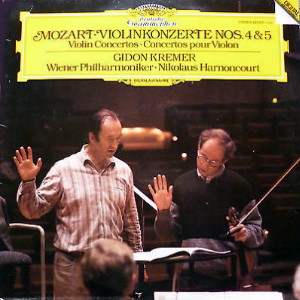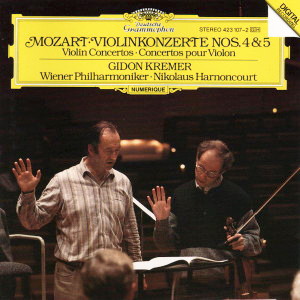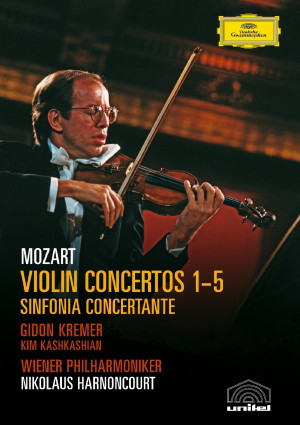 |
1 LP -
423 107-1 - (p) 1987
|
 |
| 1 CD -
423-107-2 - (p) 1987 |
 |
| 2 DVD -
0440 073 4157 5 - (c) 2006 |
|
| Wolfgang
Amadeus Mozart (1756-1791) |
|
|
|
|
|
|
|
| Konzert für Violine und
Orchester Nr. 4 D-dur, KV 218 |
|
22' 02" |
|
- Allegro
|
8' 15" |
|
A1
|
- Andante
cantabile
|
6' 07" |
|
A2
|
- Rondeau. Andante grazioso
- Allegro ma non tropo
|
7' 40" |
|
A3
|
Konzert
für Violine und Orchester Nr. 5 A-dur,
KV 219
|
|
27' 42" |
|
- Allegro aperto
|
8' 58" |
|
B1
|
| - Adagio |
9' 53" |
|
B2
|
| - Rondeau. Tempo di Menuetto
|
8' 51" |
|
B3
|
|
|
|
|
| Gidon
Kremer, Violine |
|
|
|
| WIENER
PHILHARMONIKER |
|
| Nikolaus
Harnoncourt, Dirigent |
|
|
Luogo
e data di registrazione
|
| Großer
Saal, Konzerthaus, Vienna (Austria) -
gennaio 1987 |
|
Registrazione
live / studio
|
| studio |
Producer
/ Engineer
|
Hanno
Rinke / Wolfgang Mitlehner
|
Prima Edizione CD
|
| Deutsche
Grammophon - 423 107-2 - (1 cd) - 50'
04" - (p) 1987 - DDD |
Prima
Edizione LP
|
Deutsche
Grammophon - 423
107-1 - (1
lp) - 50'
04"
- (p) 1987
- Digital
|
Edizione
DVD
|
| Deutsche Grammophon - 0440 073
4157 5 - (2 dvd) - 92" 00" + 61' 00" -
(c) 2006 - GB |
|
|
Notes
|
These
two
violin concertos date from shortly
before Mozart's 20th birthday.
There can be no
doubt that he wrote them for himself
to play, as part of his duties as
Konzertmeister to
the Prince Archbishop
of Salzburg. They clearly reveal the
influence of the Italian
tradition of
composers like Pietro Nardini, Gaetano
Pugnani and Antonio Vivaldi,
especially in the
formal layout, while melodically they
reflect the contemporary
French style or the "Turkish" style
then in fashion.
When Mozart writes from
Augsburg in 1777
that he has played the
"Strasbourg Concerto" ("it flowed
like oil"), or his father notes with
pride that the
vice-Konzertmeister Antonio
Brunetti has performed it in the
interval of a play, in order to give
the actors time to change, it is to K.
218 that they refer.
Mozart may well have known one of the
symphonies of Dittersdorf, in which
the title “Ballo Strasburghese" is
given to a melody “à la
musette"; a variation on the same
melody appears in K. 218, weaving
through the Rondeau,
and showing Mozart`s delight in its
folk character. Mozart`s use of the
French form of the word “rondeau", or
of the direction "grazioso" - which
was popular in French court music in
the galant style - as a
designation for the andante
musette theme, makes it clear that the
young composer’s conscious cultivation
of the foreign style goes beyond
melodic borrowings. He is paying
homage to a fashion. For the same
reason, this was the only concerto to
go with him in his baggage when
he set off on the road
to Paris via Mannheim. In Mannheim
they called the march-like unisono
of the opening tutti of the first
movement an “orchestral curtain". It
had degenerated
since it was new into a common,
conventional and uninspired form of
orchestral opening
in broken chords,
a modish routine. But
Mozart’s development from this
commonplace beginning,
with the violin picking its way
lightly and gracefully above the throh
of the violas, is
inimitable in the way it
simultaneously provides a contrast to
tho first four-bar group and builds a
unified form: it is Mozartian to the
core.
The autograph score of K.
219 is one of the
most highly prized possessions ot tho
Library of Congress
in Washington, DC. Leafing through it,
one is soon
transported by an unexpected Adagio to
an idyllic spot where the solo violin
soars dreamily above the murmur of the
orchestral violins, before plunging
manfully into the Allegro at last. The
notes of the chord of A major,
previously heard as if in a reverie,
are now presented in a brisk, dotted
rhythm, adapted to the new tempo, a
wholly innovatory procedure at the
time. Other things
are more conventional: sighs are
raised, curtsies and bows are sketched
, galant conversation is made
(as in the Adagio) between the soloist
and the orchestra, The minuet theme
(3/4), neatly pigtailed, makes a
decorous entrance into the Rondeau,
but springs a few surprises (chromatic
suspensions, minor-mode unisono) in its last
stages. These are precursors of the
interpolated tuttis in the minor,
which are quotations from an earlier
work of Mozart’s, the ballet Le gelosie
del serraglio (K. A109),
from the 1772 opera Lucio Silla.
The original ballet gave them a
Turkish setting, but even
in the non-dramatic context of
a violin concerto, a
piece of “absolute music", they carry
“Turkish” associations -or rather,
associations of the musical phenomenon
that was designated "alla turca” in
Mozart`s day, namely the music of the
Janissaries, the élite
troops of the
Ottoman Empire, which had a
strong Hungarian flavour. When Mozart
directs the double basses to play col
legno, there is no mistaking the
imitation of a big bass drum beaten
with wooden sticks. Wherever the
cradle of this minor-mode music
ultimately lies, with its narrow
intervals, its brief
and twirling
motives, its vehement sforzando accents, we
must be grateful for the incursion of
its oriental exoticism into our
concert halls.
Roland Würtz
Translation: Mary Whittal
|
|
Nikolaus
Harnoncourt (1929-2016)
|

|

|
|